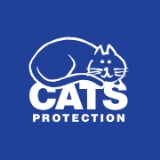
Cats Protection
Encyclopedia
Cats Protection, formerly The Cats Protection League, is a UK
charity
dedicated to rescuing and rehoming stray, unwanted or homeless cat
s and educating people about cats and cat welfare. The organisation was founded as The Cats Protection League on May 16, 1927 at a meeting in Caxton Hall
, London
. The name was shortened in 1998.
and re-releasing (where possible) feral cats back to where they came from.
In 2002, Cats Protection acquired the Isle of Thorns estate from the University of Sussex
.
The estate is now the National Cat Centre.
Visit the website to find out more about neutering, rehoming or volunteering for Cats Protection. Or look for Cats Protection on Facebook and Twitter
United Kingdom
The United Kingdom of Great Britain and Northern IrelandIn the United Kingdom and Dependencies, other languages have been officially recognised as legitimate autochthonous languages under the European Charter for Regional or Minority Languages...
charity
Charitable organization
A charitable organization is a type of non-profit organization . It differs from other types of NPOs in that it centers on philanthropic goals A charitable organization is a type of non-profit organization (NPO). It differs from other types of NPOs in that it centers on philanthropic goals A...
dedicated to rescuing and rehoming stray, unwanted or homeless cat
Cat
The cat , also known as the domestic cat or housecat to distinguish it from other felids and felines, is a small, usually furry, domesticated, carnivorous mammal that is valued by humans for its companionship and for its ability to hunt vermin and household pests...
s and educating people about cats and cat welfare. The organisation was founded as The Cats Protection League on May 16, 1927 at a meeting in Caxton Hall
Caxton Hall
Caxton Hall is a building on the corner of Caxton Street and Palmer Street, in Westminster, London, England. It is a Grade II listed building primarily for its historical associations...
, London
London
London is the capital city of :England and the :United Kingdom, the largest metropolitan area in the United Kingdom, and the largest urban zone in the European Union by most measures. Located on the River Thames, London has been a major settlement for two millennia, its history going back to its...
. The name was shortened in 1998.
Aims
- To find good homes for cats in need
- To support and encourage the neuteringNeuteringNeutering, from the Latin neuter , is the removal of an animal's reproductive organ, either all of it or a considerably large part. The process is often used in reference to males whereas spaying is often reserved for females. Colloquially, both terms are often referred to as fixing...
of cats - To improve people's understanding of cats and their care
Operations
In 2010 the charity helped over 230,000 cats and its network had 29 adoption centres (formerly shelters), 256 voluntary-run branches, one rehoming centre, 63 charity shops and approximately 7,800 volunteers located throughout the UK. The charity's income for 2009 was £34.7 million. Alongside re-homing cats and kittens, the charity runs a neutering scheme for owners on a limited income, and a national helpline (03000 12 12 12) In addition, they monitor (and feed) feral colonies in the area including trapping, neuteringNeutering
Neutering, from the Latin neuter , is the removal of an animal's reproductive organ, either all of it or a considerably large part. The process is often used in reference to males whereas spaying is often reserved for females. Colloquially, both terms are often referred to as fixing...
and re-releasing (where possible) feral cats back to where they came from.
Volunteer branches
The charity operates in two ways: volunteer-run branches and adoption centres (formerly shelters). The main difference is that volunteer-run branches are people with a spare room or space in a garden for a pen (or two). Instead of visiting a dedicated adoption centre, the person wishing to adopt a cat usually visits it in another person's home. Anyone picking up a cat or kitten from a fosterer's home is still subject to the same home visits (pre and post homing) and the same terms and conditions as someone picking up a cat or kitten from an adoption centre. Volunteer-run branches do receive a small amount of funding from the charity's headquarters but are required to raise most of their funds from their local areas. They do not usually have any paid members of staff.Adoption Centres
Dedicated adoption centres are of varying size and have paid staff in addition to volunteers on their team. The vast majority of the public visit these places to adopt a cat or a kitten. Adoption centres are funded centrally by the charity, though many also have "Friends of..." groups that raise funds locally. In addition, there is often the chance of cat cabin sponsorship where members of the public are offered the chance to have their name on a plaque attached to the pen in return for a monthly or annual donation. Most pen sponsorships are done by individuals, although in some cases companies may sponsor a cat cabin. As well as a plaque, the person sponsoring it usually receives a regular update.In 2002, Cats Protection acquired the Isle of Thorns estate from the University of Sussex
.
The estate is now the National Cat Centre.
External links
Visit the website to find out more about neutering, rehoming or volunteering for Cats Protection. Or look for Cats Protection on Facebook and Twitter

